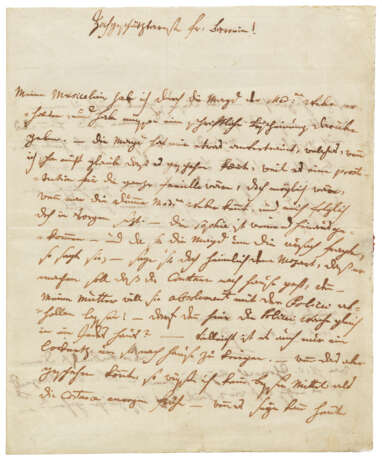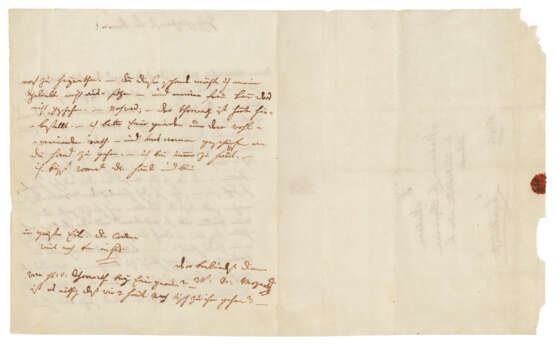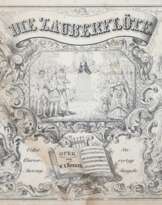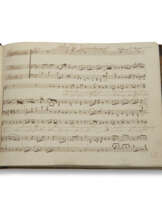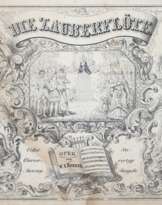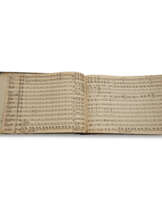ID 1109044
Lot 244 | Wolfgang Amadeus Mozart (1756-1791)
Estimate value
£ 150 000 – 200 000
Autograph letter signed ('W: A: Mozart') to [Martha Elisabeth] Baroness von Waldstätten, [Vienna, shortly before 4 August 1782]
In German, with a few words in French ('Musicalien', 'prostitution', 'famille', 'absolument', 'Costance'). Two pages, 228 x 187mm. Integral address leaf ('À Madame / Madame La Baronne de Waldstaetten nèe de Schoeffer / à Leopoldstatt / N: 360'). Watermark 'D & C BLAUW'. Remnant of seal in red wax. Provenance: Gustav Moritz Clauß (1796-1871, autograph collector, Leipzig: as noted by Otto Jahn, 1856); private collection, London (as noted in Bauer/Deutsch, Briefe, 1963); Christie’s London, 21 June 1989, lot 192, 'The property of a gentleman'.
'Most highly esteemed Baroness!
I received my music from Madame Weber's maid, and had to give a written receipt. The maid confided something to me which, even though I don't believe that it could happen because it would amount to prostitution for the whole family, would still be possible if you know stupid Madame Weber, and consequently has put me in some trouble. Sophie came out crying, and when the maid asked her the cause, she said "Tell Mozart secretly that he should ensure that Constanze goes home, because – my mother absolutely wants to have her picked up by the police!". Are the police allowed to go into any house here? Maybe it's just a decoy tactic to get her home. But if it might actually happen, then I know of no better solution than to marry Constanze tomorrow morning – today if at all possible. For I do not wish to expose my beloved to this shame – and it cannot happen if she is my wife. One other thing: Thorwart is called away today. I ask you for your kind advice, and to offer a helping hand to us poor creatures. I am still at home. I kiss your hands 1000 times and am
your most devoted servant
W: A: Mozart m.p.
In the greatest haste (Constanze still knows nothing of this)
Has Herr von Thorwart been to see you? –
Should the two of us to go to him after dinner today? –' (translation)
A breathless letter by the 26-year old Mozart on the farcical circumstances preceding his marriage to Constanze Weber. Mozart has taken delivery of some music from the maidservant of Constanze's mother, who has used this as a pretext for getting a written receipt (possibly with the intention of demonstrating that Mozart and Constanze are already cohabiting). The maid has confided in him Madame Weber's scheme to send the police to pick up Constanze, which seems incredible 'because it would amount to prostitution for the whole family, but would still be possible if you know stupid Madame Weber'. Mozart declares that the only solution is for him to marry Constanze the next day – or the same day if at all possible. He signs off 'in the greatest haste', kissing the Baroness's hands 'a thousand times', and referring to Constanze's guardian, Johann von Thorwart.
Mozart's marriage to Constanze Weber on 4 August 1782 was one of two concurrent events – alongside the hugely successful premier of his opera Die Entführung aus der Serail just under three weeks before – which definitively marked his emancipation from the two figures of authority who had loomed over the early years of his adulthood. These were Archbishop Colloredo, the ruler of Salzburg, and Mozart's own father, Leopold, the deputy Kapellmeister in the Archbishop's court.
Mozart had arrived in Vienna on 16 March 1781 as a member of the salaried retinue of the Archbishop, for what was supposed to be a short stay. He had other plans however and within six weeks made him self so unbearable that he was literally kicked out of the Archbishop's household by the latter's steward. This left him the greatest composer alive, but with no financial means and nowhere to live. The solutions he sought for both issues were to meet with stiff opposition from his father. For the first, he began seeking musical commissions and putting on independent concerts around Vienna, sometimes in apartments and the ballrooms of restaurants. The second problem he resolved by seeking lodgings with the Weber family, old friends from his brief stay in Mannheim in late 1777 (when he had in fact already fallen in love with their second daughter, the talented soprano Aloysia).
The household, which occupied the second floor of a building named Zum Auge Gottes, consisted of the widowed Maria Cäcilia Weber, and her three unmarried daughters, Josepha, Constanze (then 19 years old – Mozart was 25) and Sophie. By July, there were already rumours that Mozart was going to marry one of the three daughters, to which he light-heartedly responded in a letter to his anxious father, ‘If I had to marry all the girls that I've had a laugh with, I'd have easily 200 wives’. By September the gossip was becoming sufficiently embarrassing to oblige him to move out to separate lodgings, and on 15 December he broached the prospect of marriage to Constanze in a letter to Leopold (‘Who is the object of my affections? – Please don’t be alarmed. – Surely not one of the Webers? …’); a week later he admitted that he had already given a written promise that he would marry Constanze within three years to her guardian, Johann von Thorwart, an influential figure in Viennese theatre .
There were some difficulties in the ensuing courtship – not least because of Leopold’s reluctance to give his consent and doubts over Mozart’s financial resources. But the young couple evidently received encouragement from the recipient of the present letter, Baroness von Waldstätten, who invited Constanze to stay at her house in Leopoldstadt outside Vienna on several occasions (including in April 1782 when Mozart flew into rage after a parlour game involving a male guest measuring Constanze's calves). By late July, Mozart had made it clear to his father that he and Constanze were already in a sexual relationship, and she had evidently moved out of her mother's house, although it is not clear from the present letter whether she was staying, as previously, with the Baroness, or in fact already living with Mozart in his new apartment in Vienna.
Whether driven to a decision by his future mother-in-law or not, Mozart wrote to Leopold on 27 July begging his father to grant his long-delayed consent to their marriage. He and Constanze took communion together on 2 August, signed a marriage contract on the 3rd, and on the 4th were married at St Stephen’s Cathedral, with the baroness throwing a ‘princely’ wedding supper; Leopold’s letter granting his reluctant permission arrived on the following day. Echoing the name of his opera (which translates as The Abduction from the Seraglio) and of the Webers' house, Zum Auge Gottes, Mozart cheerfully referred to the successful conclusion of events as 'die Entführung aus dem Auge Gottes'.
Constanze Mozart (1762-1842) was one of a highly musical family, and like her sisters trained as a singer: in a letter to his sister Nannerl in April 1782, Mozart attributes to Constanze his newfound interest in counterpoint, and she was to sing the 'Et incarnatus est' at the first performance of his Great Mass in C minor (K.427) during a visit to Salzburg in October 1783 (when she met Leopold and Nannerl for the first time). In their nine years of married life, Mozart and Constanze were to have six children, though only two survived infancy. Her husband's death in 1791 left her in difficulties, but after securing a pension from the Emperor and arranging a campaign of publication of Mozart’s works, Constanze went on to achieve financial security, and she was to leave the considerable sum of 30,000 florins at her death in 1842. She collaborated on two of the earliest biographies of Mozart, by Franz Xaver Niemetschek (1798) and by her second husband Georg Nikolaus von Nissen (1829).
The connections between Mozart and the broader Weber family were numerous: he wrote arias for Aloysia both in Mannheim and in Vienna where she established a successful singing career from 1779. Aloysia was to perform the part of Donna Anna in the Viennese premiere of Don Giovanni in 1788, and the eldest sister, Josepha, was the Queen of the Night in the premiere of The Magic Flute. Meanwhile, Aloysia’s husband, the actor and amateur artist Joseph Lange, produced one of the best-known portraits of Mozart at around the time of his marriage. In spite of his rudeness about Cäcilia Weber in the present letter, Mozart’s relationship with his mother-in-law was ultimately very affectionate: Sophie Weber later remembered him bringing her coffee and sugar for her afternoon drink.
Autograph letters by Mozart are rare at auction: Rare Book Hub records only one sale in the last ten years (Christie's New York, 2017). Published: Bauer/Deutsch no. 683.
| Artist: | Wolfgang Amadeus Mozart (1756 - 1791) |
|---|---|
| Place of origin: | Austria |
| Artist: | Wolfgang Amadeus Mozart (1756 - 1791) |
|---|---|
| Place of origin: | Austria |
| Address of auction |
CHRISTIE'S 8 King Street, St. James's SW1Y 6QT London United Kingdom | |||||
|---|---|---|---|---|---|---|
| Preview |
| |||||
| Phone | +44 (0)20 7839 9060 | |||||
| Buyer Premium | see on Website | |||||
| Conditions of purchase | Conditions of purchase |
